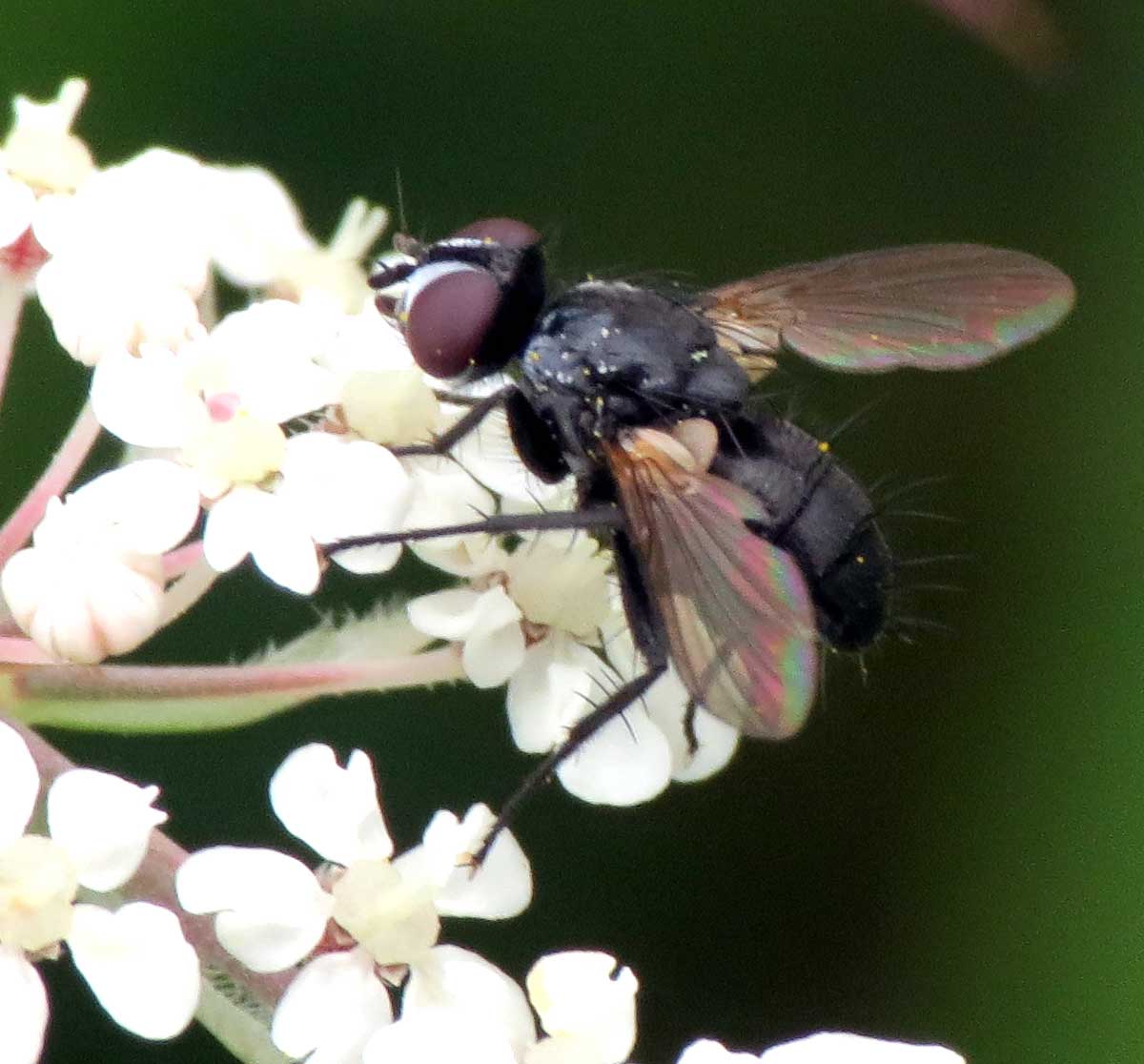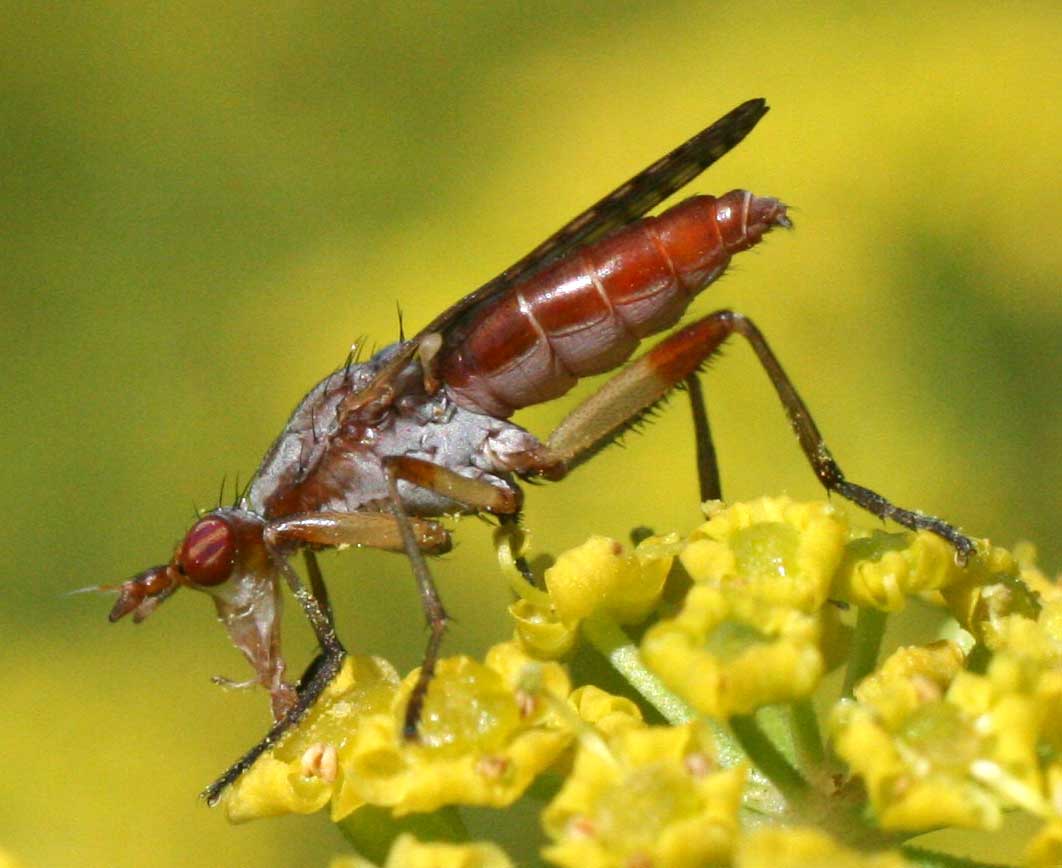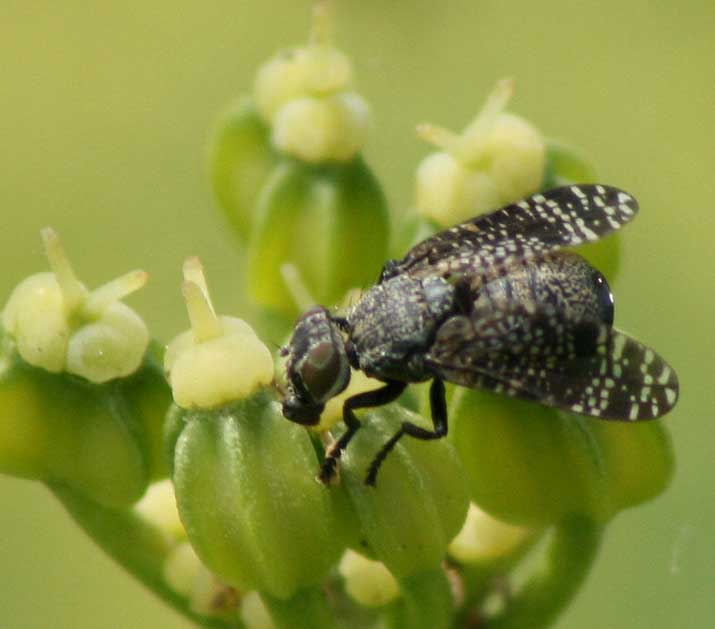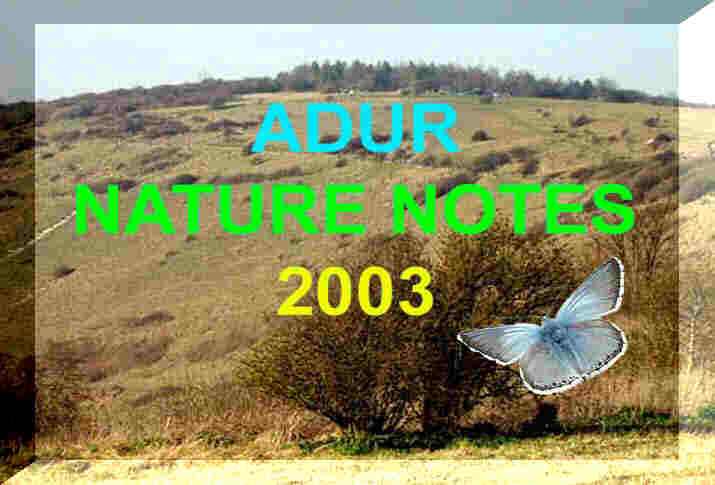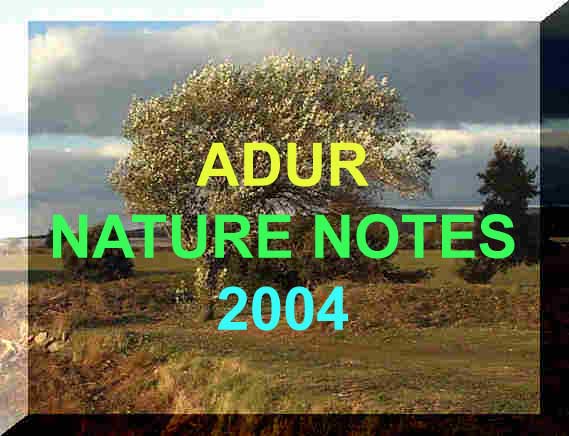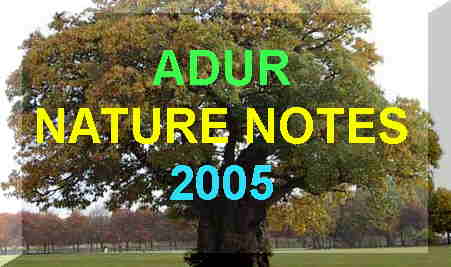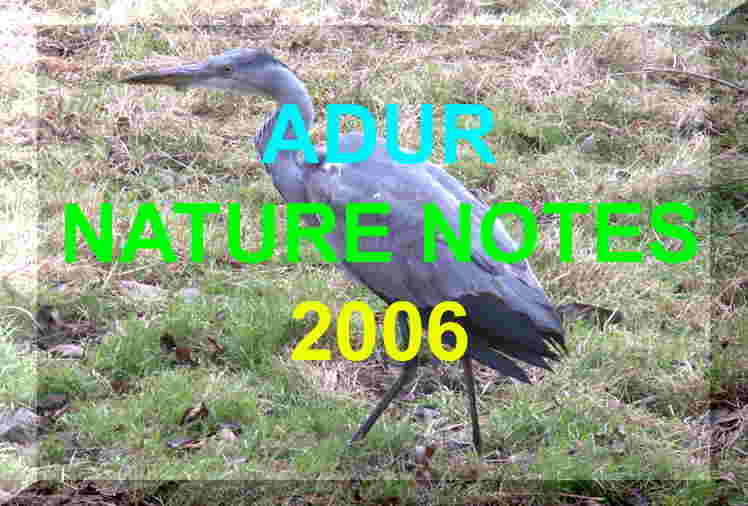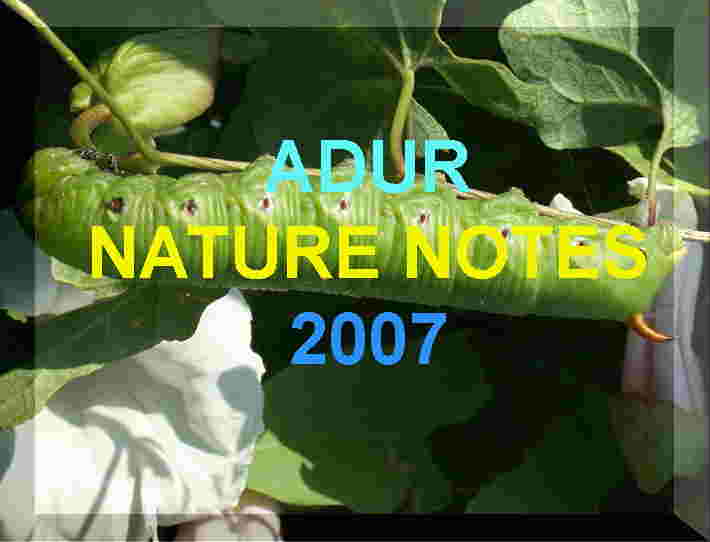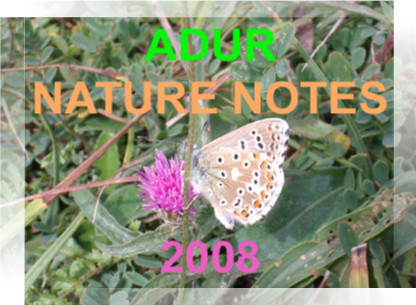 Flies
of the lower Adur Valley including Shoreham-by-Sea
Flies
of the lower Adur Valley including Shoreham-by-Sea2021
22 March 2021

A
Common
Bee-fly,
Bombylius
major, on Pussy
(=Goat) Willow, Downs Link,
south
of the Cement Works
17
August 2020
About
a hundred lively butterflies
on the lower slopes of Mill Hill, on a humid afternoon, were led in frequency
by Meadow Browns,
with an ambush predator the Hornet Robber
Fly stalking the winding path and southern
steps.
6 July
2020
The
tiny fruit fly Oxyna was
seen on Yarrow
for the first time on Mill Hill. A Kite-tailed
Robberfly, Tolmerus atricapillus,
waited in ambush on the southern steps.
Four-lined
Horsefly, Atylotus
rusticus
Downs
Link Path, south of the Cement Works (dis)
iSpot
entry
9 April
2020
A
Common
Bee-fly visited the Dog
Violets that were scattered over the lower
slopes of Mill Hill, the land now dried
after the recent dry weather.
22
August 2019
An
ambush predator, the Kite-tailed Robberfly,
Tolmerus
atricapillus, waited on a Bramble leaf
on the lower slopes of Mill Hill.
5 August
2019
A
predatory
Hornet Robber Fly,
Asilus
crabroniformis, landed on the middle
slopes of Mill Hill.
29
July 2019
A
predatory
Hornet Robber Fly,
Asilus
crabroniformis, landed on the Pixie
Path to Mill Hill.
16
July 2019
The
ambush predator, the Kite-tailed Robberfly,
Tolmerus
atricapillus, waited on a Bramble leaf
on the middle slopes of Mill Hill.
 |
27
June 2019
This tiny fruit fly is Oxyna, cf. nebulosa. It was found on the verges of the Downs Link Cyclepath south of the Cement Works. |
| 19
June 2019
This fly was too well camouflaged to be recognised in the field on a Greater Knapweed on Mill Hill. It is likely to be a Conopid fly, probably Sicus ferrugineus. This is a widespread species that is not often recorded. The Greater Knapweed attracted scores of bumblebees and the larvae of this fly are endoparasites of bumblebees, overwintering in their victims. The flies inject an egg into the bumblebees. |
25
March 2019
A
Common
Bee-fly,
Bombylius
major, visited the first few Cowslips
on the the verges of the Downs Link Cyclepath
south of the Cement Works.
 |
9
July 2018
Kite-tailed Robberfly, Tolmerus atricapillus at Mill Hill |
| 31
August 2017
The Robber Fly, Machimus atricapillus, was spotted amongst some fresh blackberries on the middle slopes of Mill Hill. This could be Machimus rusticus Renamed Kite-tailed Robberfly - Tolmerus atricapillus |
| 6
April 2017
A Common Bee-fly, Bombylius major, was seen near Ladywells, on the Coombes Road. |
 |
| 30
March 2017
South
of the Cement Works and my first two Dotted
Bee-flies,
Bombylius
discolor, of the year visited the
yellow drooping flowers of the frequent
Cowslips.
|
 |
1 August 2016
Scorpion Fly, Panorpa amongst the Privet on Mill Hill |
24
June 2016
The smaller Robber Fly, Machimus atricapillus, were occasionally seen (10+) and were seen mating on the lower slopes of Mill Hill. There were more of this predator than seen before. Cattle were grazing in the pasture to the east of Mill Hill and sheep in the nearer meadow below (to the west). |
18
May 2016

Crane-flies were seen in a field next to Ladywells.
12
April 2016
A
Buzzard
soared
over the lower slopes of Mill
Hill in the bright blue sky. Common
Bee-Flies,
Bombylius
major, were frequently seen.
Subsequent
perusal of the blurry photographs showed one of the Bee-flies
had dotted wings indicating the scarce Dotted
Bee-fly, Bombylius
discolor.
Identifying
bee-flies in genus Bombylius
10
August 2015
Two
robber
flies were noted: the smaller Robber
Fly, Machimus atricapillus,
on the southern steps of
Mill Hill and
the much larger Hornet Robber Fly,
Asilus
crabroniformis, on the top meadow.
Both
of these flies will prey on butterflies
19
July 2015
The
predatory
Robber Fly, Machimus
atricapillus, was seen at least twice
on the lower slopes of Mill Hill.
9 April
2015
My
first Common
Bee-Fly,
Bombylius
major, of the year was spotted visiting Ground
Ivy on the cyclepath
verges, north of Old Shoreham.
 |
18
September 2014
Crane-flies were seen frequently. This one was photographed on Anchor Bottom. |
| 15
August 2014
Phania funesta |
 |
31
July 2014
Hornet Robber Fly, Asilus crabroniformis Top of The Drive & Buckingham Cutting south verge |
9 April
2014
A
Common
Bee-Fly,
Bombylius
major, (first of the year) was spotted on the Waterworks
Road, Old Shoreham.
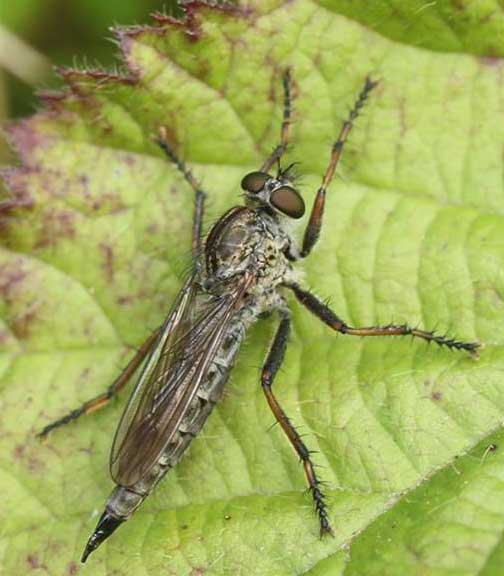 |
19
August 2013
Robber Fly on the lower slopes of Mill Hill It looks like Machimus atricapillus ... the antennae look good for it (the very similar M. cingulatus has a slightly shorter arista) and is associated with chalk and limestone grassland. ID
by Tim
Ramson
Under
Enquiry (link)
|
| 8
August 2013
Robber Fly (unidentified) It is possible that it was a species of the Machimus-group of Robber-flies |
7 August
2013
A
Hornet
Robber Fly, Asilus
crabroniformis, landed on the Pixie
Path in front of me. (ID not certain.
It might have been the fly above.)
 |
21
May 2013
Bibio species, St. Mark's Fly were common over the Pixie Path to Mill Hill. This fly comes out in large batches on the downs and their abundance can be a by nuisance. |
 |
4
October 2012
Crane-flies were seen on the lower slopes of Mill Hill. |
 |
11
September 2012
I spotted my first Hornet Robber Fly, Asilus crabroniformis, of the year on the middle slopes of Mill Hill (Triangle area). |
| 25
July 2012
Dichetophora (Sciomyzidae) fly on the upper part of Mill Hill. It is most likely to be Dichetophora obliterata (female). cf. ID on Diptera.info by Mucha Fero and Jonas Mortelmans Dichetophora
obliterata: an
attractive fly with a rust coloured abdomen and grey thorax. The thighs
are quite distinctive, being orangey-red just above the knee joint but
pale in the upper parts nearer to the body. This widespread species is
known as a snail-killing fly. The larvae are predatory on snails.
|
2 April
2012
There
was a chill breeze and no butterflies were
seen in the afternoon, not on the Waterworks
Road where the two Bee-flies
visiting the patch of Ground Ivy
were too energetic to photograph or even to identify to species species
they would not settle. They were paler than normal, one was a pale orange
when viewed from the side.
26
March 2012
A
Common
Bee-Fly,
Bombylius
major, (first of the year) was spotted over the path amongst the
Hawthorn scrub on Mill Hill.
| 11
August 2011
Robber Fly preying on a Chalkhill Blue Butterfly on Mill Hill. |
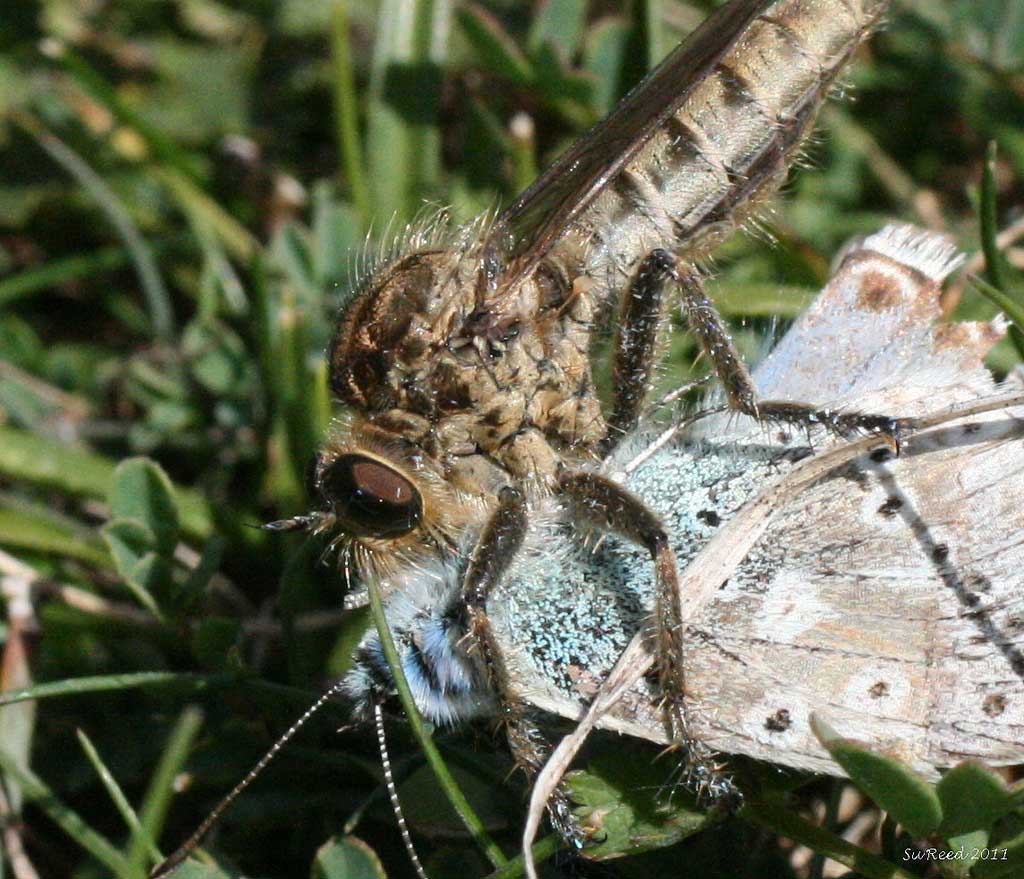 |
27
April 2011
The
predatory small Dance Fly,
Empis
tessellata was seen with its
prey of a smaller fly.
 26
April 2011
26
April 2011
Crane-flies,
Tipula,
were
mating on the lower slopes of
Mill Hill.
A handful were noted, but I expect there were many more.
8 April
2011
Common
Bee-Flies,
Bombylius
major, flitted around the Butterfly Copse near the Waterworks
Road, Old Shoreham.
3 April
2011
A
Common
Bee-Fly,
Bombylius
major, was also spotted amongst the Dog
Violets on the
lower slopes of Mill Hill. There was another
one amongst the Alexanders at the top of
Buckingham Park, north Shoreham.
22
March 2011
The
first Bee-fly
of the year was seen on the southern steps to the lower slopes of Mill
Hill. It was not identified to species.
1 August
2010
Two
large Hornet Robber Flies,
Asilus
crabroniformis, my first of the year
settled on the Pixie Path (next to Frampton's
Field, Old Shoreham).
18
April 2010
A
Dotted
Bee-fly, Bombylius
discolor, was spotted hovering about
and visiting Dog Violets on
the lower slopes of Mill Hill. Its
identity was confirmed by a poor photograph.
Dotted
Bee-flies Information
| 5
June 2010
Fly, Platystoma seminationis on Alexanders, Mill Hill. |
| 17
April 2010
Small flies on Dove's Foot Cranesbill. |
11
April 2010
At
least two Common Bee-Flies,
Bombylius
major, were seen in the Butterfly Copse next to the the Waterworks
Road.
9 April
2010
The
first Bee-flies
of the year were seen near where Cowslips
were in flower on the Downs-Coastal
Link Cyclepath.
23
July 2009
Under
a cloudy sky at the top of the Pixie Path the
first Hornet Robber Fly
of 2009 settled
briefly.
6 April
2009
Three
Bee-flies
in the north-west scrub on Mill Hill did
not settle. They were most likely to be the rarer Dotted
Bee-fly seen in this location before.
However, it was a Common Bee-Fly,
Bombylius
major, that landed on the steps of the Butterfly Copse next to
the Waterworks Road.
5
April 2009
There
were frequent Dotted Bee-flieshovering
in mid-air and visiting Ground Ivy
on the Coastal Link Cyclepath near the Cement
Works.
Dotted
Bee-flies Information
29
March 2009
An
unexpected treat was three or four individual Dotted
Bee-flies, Bombylius
discolor, using their long feeding
tubes to take nectar on a large patch of Ground
Ivy, Glechoma hederacea.
Previous Record on Mill Hill
23
March 2009
At
least two Common Bee-Flies,
Bombylius
major, were also spotted hovering over the vegetation bordering
the grassy area at the top of Chanctonbury Drive,
Shoreham, south-east of the bridge over the A27
to Mill Hill.
| 22
June 2008
The small Soldier Fly, Chloromyia formosa, illustrated on the left was seen occasionally and was probably frequent at the top of Buckingham Park, Shoreham, amongst the vegetation under the canopy of trees. This is not a hoverfly. Marmalade Flies, Episyrphus balteatus, were seen on Mill Hill. |
 |
 |
6
June 2008
A few of the distinctive Panorpa flies were seen amongst the Privet and Brambles on the lower slopes of Mill Hill. |
11
April 2008
On
a breezy afternoon, the first two Common
Bee-flies,
Bombylius
major, of 2008,
buzzed over footpath that runs along the south of Frampton's Field, and
another one was seen at the top (north) of The Street, Old Shoreham.
29
March 2008
|
Image of Fly |
| 1
February 2008
A fly on a Dandelion at the top of McIntyres Field, north Lancing, was my first fly noted this year. |
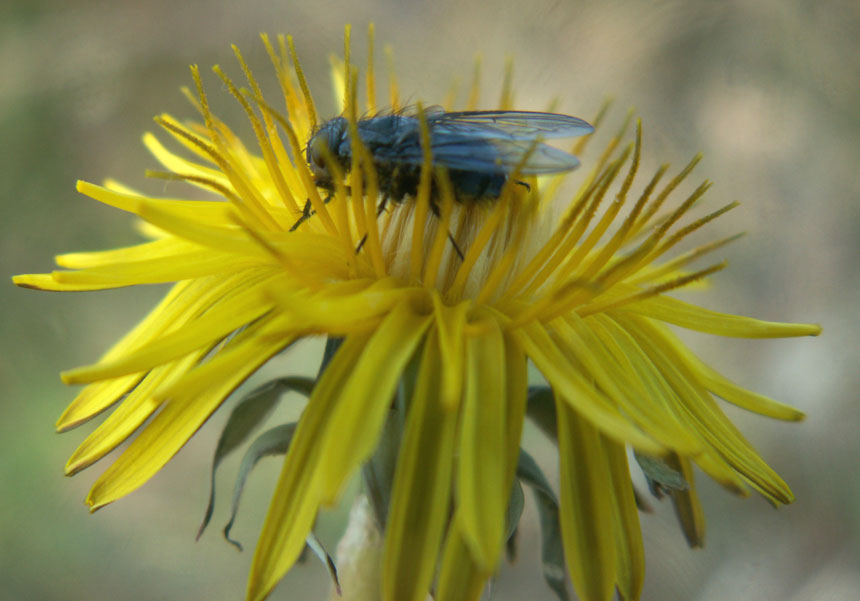 |
 |
25
September 2007
AHornet Robber Fly was seen on the Slonk Hill Cutting south in the open overgrown bit east of the hedgerows that close in on the path. |
 |
12
September 2007
A Hornet Robber Fly was seen on Mill Hill south of the Reservoir. These flies are very wary and I find it nigh impossible to get near enough for a decent photograph. |
|
The first Hornet Robber Fly seen this year was seen on the Buckingham Cutting south. |
 |
2 July
2007
 |
 |
 |
| 2
March 2007
In a brief burst of early afternoon sunshine, I spotted my first Dung Fly at the top of Chanctonbury Drive (SE of the bridge to Mill Hill). |
 |
.jpg)

.jpg)



